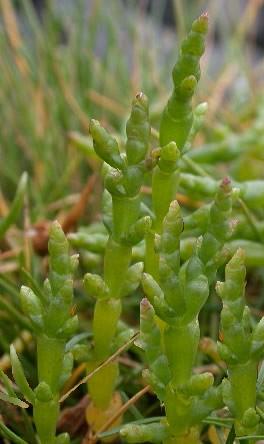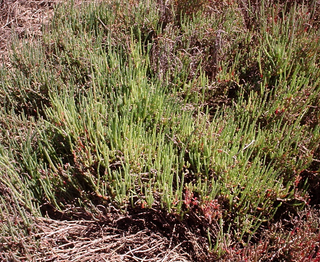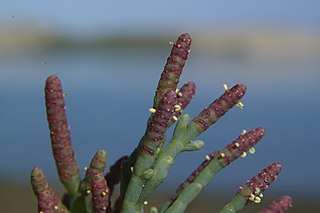
Salicornia is a genus of succulent, halophytic flowering plants in the family Amaranthaceae that grow in salt marshes, on beaches, and among mangroves. Salicornia species are native to North America, Europe, Central Asia, and southern Africa. Common names for the genus include glasswort, pickleweed, picklegrass, and marsh samphire; these common names are also used for some species not in Salicornia. To French speakers in Atlantic Canada, they are known colloquially as 'titines de souris'. The main European species is often eaten, called marsh samphire in Britain, and the main North American species is occasionally sold in grocery stores or appears on restaurant menus as sea beans, samphire greens or sea asparagus.

Samphire is a name given to a number of succulent salt-tolerant plants (halophytes) that tend to be associated with water bodies.
Sarcocornia is a formerly recognized genus of flowering plants in the amaranth family, Amaranthaceae. Species are known commonly as samphires, glassworts, or saltworts. Molecular phylogenetic studies have shown that when separated from Salicornia, the genus is paraphyletic, since Salicornia is embedded within it, and Sarcocornia has now been merged into a more broadly circumscribed Salicornia. When separated from Salicornia, the genus has a cosmopolitan distribution, and is most diverse in the Cape Floristic Region of South Africa.

The Salicornioideae are a subfamily of the flowering plant family Amaranthaceae. Important characters are succulent, often articulated stems, strongly reduced leaves, and flowers aggregated in thick, dense spike-shaped thyrses. These halophytic plants are distributed worldwide. Many are edible
Saltwort is a common name for various genera of flowering plants that thrive in salty environments, typically in coastal salt marshes and seashores, including:
British NVC community SM10 is one of the salt-marsh communities in the British National Vegetation Classification system. This community is found in coastal areas in the Solway Firth, south Cumbria, Lancashire, west and south Wales, Hampshire, The Wash and north Lincolnshire. There are no subcommunities.

The glassworts are various succulent, annual halophytic plants, that is, plants that thrive in saline environments, such as seacoasts and salt marshes. The original English glasswort plants belong to the genus Salicornia, but today the glassworts include halophyte plants from several genera, some of which are native to continents unknown to the medieval English, and growing in ecosystems, such as mangrove swamps, never envisioned when the term glasswort was coined.

Tecticornia is a genus of succulent, salt tolerant plants largely endemic to Australia. Taxa in the genus are commonly referred to as samphires. In 2007, the genus Halosarcia, along with three other Australian genera was incorporated into the genus.

Salicornia quinqueflora, synonym Sarcocornia quinqueflora, commonly known as beaded samphire, bead weed, beaded glasswort or glasswort, is a species of succulent halophytic coastal shrub. It occurs in wetter coastal areas of Australia and New Zealand.

Tecticornia arbuscula, the shrubby glasswort or scrubby samphire, is a species of plant in the family Amaranthaceae, native to Australia. It is a shrub that grows to 2 metres in height, with a spreading habit. It has succulent swollen branchlets with small leaf lobes.

Salicornia bigelovii is a species of flowering plant in the family Amaranthaceae known by the common names dwarf saltwort and dwarf glasswort. It is native to coastal areas of the eastern and southern United States, Belize, and coastal Mexico. It is a plant of salt marshes, a halophyte which grows in saltwater. It is an annual herb producing an erect, branching stem which is jointed at many internodes. The fleshy, green to red stem can reach about 60 cm in height. The leaves are usually small plates, pairs of which are fused into a band around the stem. The inflorescence is a dense, sticklike spike of flowers. Each flower is made up of a fused pocket of sepals enclosing the stamens and stigmas, with no petals. The fruit is an utricle containing tiny, fuzzy seeds. The southern part of the species range is represented by the Petenes mangroves of the Yucatán, where it is a subdominant plant associate in the mangroves.
Salicornia utahensis, synonym Sarcocornia utahensis, is a species of flowering plant in the amaranth family known by the common name Utah swampfire. It is native to the southwestern United States, where it can be found in desert habitat, generally in areas with alkaline or saline soils, such as playas. This halophytic perennial herb or subshrub grows in low matted clumps of woody stem bases anchored to the substrate by rhizome systems. The stem grows erect into fleshy green branches. The inflorescences are within the distal parts of the branches, which are ringed with tiny flat flowers.

Salicornia virginica is a halophytic perennial dicot which grows in various zones of intertidal salt marshes and can be found in alkaline flats. It is native to various regions of the Northern Hemisphere including both coasts of North America from Canada to Mexico.

Salicornia blackiana, synonym Sarcocornia blackiana, commonly known as thick-head glasswort, is a species of succulent halophytic shrub. It is widespread in southern and western Australia, including Tasmania. Its preferred habitats are estuaries, swamps and periodically waterlogged saline areas.

Salicornia europaea, known as marsh samphire, common glasswort or just glasswort, is a halophytic annual dicot flowering plant in the family Amaranthaceae. Glasswort is a succulent herb also known as ‘Pickle weed’ or ‘Marsh samphire’. As a succulent, it has high water content, which accounts for its slightly translucent look and gives it the descriptive name “glasswort.” To some people, it is known as “chicken toe” because of its shape. To others, it is called “saltwort.” It grows in various zones of intertidal salt marshes, on beaches, and among mangroves.
Hungry Bay Nature Reserve is a nature reserve on the east coast of Bermuda. It was established in 1986. It is considered the best example of coastal mangrove swamp on the island. It includes the Hungry Bay area and the largest mangrove coastal swamp in Bermuda. It is protected by a Tree preservation order (T.P.O.) and designated as an official Nature Reserve within the Parks system of Bermuda.

Salicornia pacifica, also known as pickleweed, sea asparagus, Pacific swampfire, or glasswort, is a species of low-growing perennial succulent halophyte in the genus Salicornia found in the Pacific coast of North America and California.

Salicornia rubra, the Rocky Mountain glasswort, is a species of flowering plant in the family Amaranthaceae. It is native to colder or higher areas of North America; the Yukon, Nunavut, British Columbia, Alberta, Saskatchewan, Manitoba, and Ontario in Canada, and the western and north-central US. It has been introduced to Quebec and Michigan, and has gone extinct in Illinois. A halophyte, it is one of the most salt-tolerant plants of North America.

Salicornia fruticosa, synonym Sarcocornia fruticosa, is a species of glasswort in the family Amaranthaceae (pigweeds). It is native to southern Europe, north Africa, Western Asia and Yemen. It is a halophyte, a plant that can grow in saline conditions.
Slender glasswort is a common name for several plants in the genus Salicornia, and may refer to:












